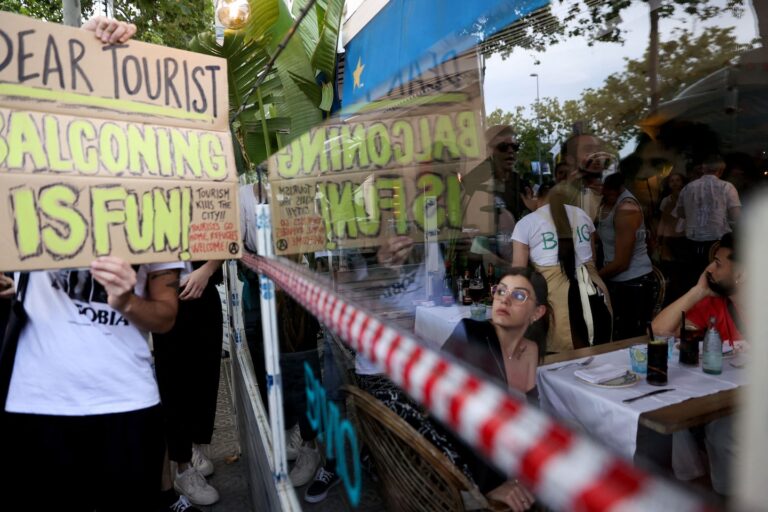BARCELONA — It was easy to sigh and cringe on a recent sun-drenched afternoon in Barcelona, Europe’s top summer destination, when local protesters squirted water guns at bemused tourists dining at a sidewalk cafe. But the anti-tourism demonstration here was also a striking snapshot — and a warning — of rising tensions on the continent and beyond, as record travel levels this summer collide with climate change, social inequality and the capacity of even the most tourist-friendly cities to accommodate them.
If you thought the world’s tourist destinations were already saturated, think again — especially the hitherto largely untapped markets of international travelers from China and India. With hundreds of millions more tourists adding to peak-season crowds over the next decade or two, places that think they’re at breaking point now will look back on this summer as the good old days.
Tourism around the world has boomed for decades, with its impact disproportionately hitting Europe, especially the Sunbelt of southern Europe. Barcelona, an achingly charming city that has soared in popularity since hosting the Olympics 32 years ago, is a prime example.
This densely packed, dreamy city of 1.6 million residents attracted fewer than 2 million tourists in 1990. This year, city officials expect nearly 13 million visitors and about 38 million overnight stays — figures that don’t include millions of cruise ship passengers or day-trippers flocking to must-see sites like Las Ramblas and Antoni Gaudi’s Sagrada Familia cathedral.
 Follow this author Lee Hockstader’s opinion
Follow this author Lee Hockstader’s opinion
Rents in the city have skyrocketed, up nearly 70 percent in a decade, driven by platforms like Airbnb, digital nomads and second-home buyers. Barcelona employs an estimated 150,000 people in the tourism industry, many of whom cannot afford to live in the city.
Similar concerns are spreading in major tourist destinations like Lisbon, Athens, Las Palmas and Ibiza, which are victims of their own success and increasingly fear losing their working-class residents, their neighborhood grocers and their souls, all of which depend on tourism.
No city in Europe is more overrun with tourists than Venice. Since the 1950s, 70 percent of its population has been driven out, and the fairy-tale city of three square miles sees more than 20 million visitors a year. This year, Venice imposed a $5.30 admission fee on day-trippers, which seems nonsensical.
Local resentment and protests against the influx of tourists are intensifying not only in southern Europe but also in Amsterdam, Tokyo, Seoul and other cities. In Barcelona, where tourism was almost universally viewed as a positive 15 years ago, almost a quarter of residents now say it has a negative impact.
“The tourism industry will probably continue doing what it has been doing and tensions between residents and tourists will increase,” Sebastian Amrhein, a tourism scholar at Rhein-Waal University in Germany, told me.
In Barcelona, I spoke with Jordi Valls, the deputy mayor for economy, taxes, promotion and tourism who took office last year and immediately decided that tourism, which accounts for almost a fifth of the city’s non-formal economy, was at its limit and could not be stopped.
“I can’t control demand,” he told me. “The only thing I can influence is supply.”
To reach that goal, the city has banned private apartment rentals and plans to eliminate an additional 10,000 short-term rentals through Airbnb and other services by 2028. The city has also increased hotel taxes, capped the construction of new hotels in the city center, and restricted the number of group tourists.
Part of the idea is to keep selfie-stick-wielding tourists from dominating public spaces — something that’s proving difficult enough in parts of the city — and then there’s the long-term strain they put on water, electricity, transport and other resources.
Equally challenging will be protecting the character of neighborhoods where outsiders have snapped up apartments. The thousands of new homes Barcelona plans to build each year are unlikely to slow the steady gentrification of the city’s English-speaking parts.
Squeezing supply tends to drive up prices, and available capacity shifts to wealthy tourists, with little or no benefit to workers. In the industry, this is known as “quality tourism,” a euphemism for wealthy tourists who put a heavy strain on the climate with their extravagant travel habits.
The end of the pandemic has seen a wave of “revenge” tourists frantically seeking out new sights after spending so much time in their living rooms. Predictions last summer that travel would ease this year have proven wrong. Revenge tourism has morphed into rampage tourism, now exceeding pre-pandemic records.
For many places, especially the sun-and-sand meccas of southern Europe, tourists are their golden egg and their economies depend heavily on them, and few are likely to muster the political will to significantly reduce tourist numbers anytime soon.
But unless governments actively diversify their economies to become less reliant on tourists and more aggressively redistribute tourism revenues to demonstrate their benefits, social protests and resource surpluses may force governments to act—unless tourists themselves grow tired of the crowds and abandon tourist destinations altogether.
It’s getting worse, literally: In the Canary Islands, anti-tourist activists recently began putting up fake “Closed Due to Overcrowding” signs near beaches.

